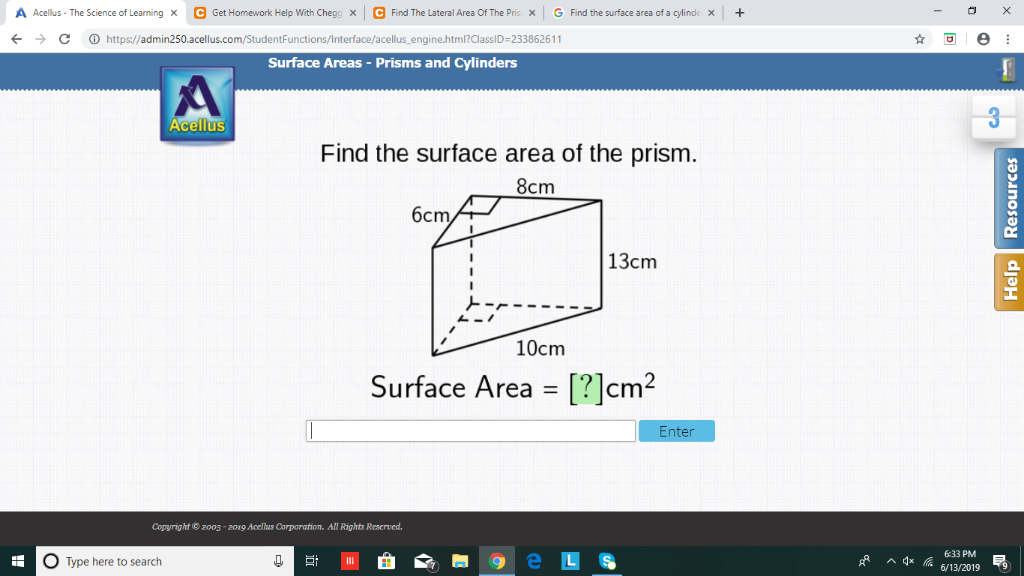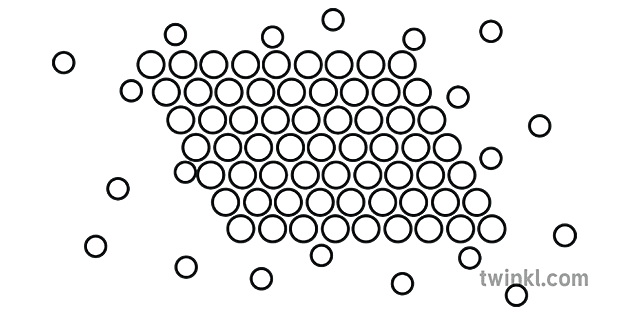41 surface area in science
Surface Area - Formula, Meaning, Examples - Cuemath The total surface area of a prism = Lateral surface area of prism + area of the two bases = (2 × Base Area) + Lateral surface area = (2 × Base Area) + (Base perimeter × height). There are seven types of prisms based on the shape of the bases of prisms. Surface Area | The Franklin Institute The property at work in this experiment is surface area. Small things have more surface area for their volume than larger things do. Some things that aren't reactive at all in big pieces are very reactive when they're tiny. The smaller the pieces of the tablet the faster it fizzes because the smaller pieces have more surface area.
Effect of surface area on rate - Factors that affect the rate of ... Effect of surface area on rate The rate of a chemical reaction can be raised by increasing the surface area of a solid reactant. This is done by cutting the substance into small pieces, or by...

Surface area in science
What is Surface Area? - Definition & Formulas - Study.com Find the surface area of a sphere having diameter 12 cm. Answers 1. The radius of the cylinder is r = 4/2 = 2 cm and the height is h = 6 cm. Hence the surface area of this cylinder is 2. The... Surface area Definition & Meaning - Merriam-Webster Definition of surface area : the amount of area covered by the surface of something The lake has roughly the same surface area as 10 football fields. Learn More About surface area Share surface area Dictionary Entries Near surface area surface-active agent surface area surface-bent See More Nearby Entries Statistics for surface area Cite this Entry Reaction Rates: When Surface Area Matters! | Lesson Plan - Science Buddies Factors that affect reaction rates include the concentrations of the reactants, the nature of the reactants, temperature, and the presence or absence of a catalyst or inhibitor. In chemical reactions, in which a solid reactant is present, the surface area of this reactant also affects the reaction rates. Explain to your students that in the ...
Surface area in science. Surface Area of a Sphere | Brilliant Math & Science Wiki To prove that the surface area of a sphere of radius r r is 4 \pi r^2 4πr2, one straightforward method we can use is calculus. We first have to realize that for a curve parameterized by x (t) x(t) and y (t y(t ), the arc length is S = \int_a^b \sqrt { \left (\frac {dy} {dt}\right)^2 + \left ( \frac {dx} {dt}\right)^2 } \, dt. Surface Area Lesson for Kids - Video & Lesson Transcript - Study.com Surface area is a measurement of all the space that the surface of a three-dimensional shape takes up (with a three-dimensional shape being a shape with height, width, and depth). In other words,... Surface area - Math Surface area In geometry, the surface area of a 3D shape or geometric figure is the amount of space occupied by its surfaces. In the figures above, the amount of material it takes to make the tent to the left is the tent's surface area. The amount of cardboard used to make the box to the right is its surface area. What is surface area in science and why is it so important? Answer: Very broadly, one description of surface area is the bit that's visible: walls as well as floors; table legs as well as table tops; people's faces; basically, the inside or outside of the outside of anything, however complicated the shape is. Very basically, surface area is so important ...
Huge Ocean Beneath the Earth's Surface Discovered By Scientists The idea of an underwater world has driven plenty of science fiction, but one group of researchers says it's not too far from science fact. They've discovered an area inside the earth's surface ... Surface Area Calculator The total surface area is calculated as follows: SA = 4πr 2 + 2πrh where r is the radius and h is the height Horatio is manufacturing a placebo that purports to hone a person's individuality, critical thinking, and ability to objectively and logically approach different situations. Importance of the Conductivity and Specific Surface Area of Electrode ... The FCDI cell used in the experimental study is illustrated in Figure 1.The effective area between the IEM and the flow-electrode suspension was 18.3 cm 2.The weight percentages of the electrode powders and the corresponding AC and CB mixing ratios in the flow-electrode suspension are listed in Table S1, typically including 2.5 wt%, 5 wt%, and 10 wt% AC, 0.5 wt% and 5 wt% CB, and 5 wt% AC-CB ... Surface Area Definition (Illustrated Mathematics Dictionary) The total area of the surface of a three-dimensional object. Example: the surface area of a cube is the area of all 6 faces added together. See: Area.
surface | Definition & Facts | Britannica surface, in chemistry and physics, the outermost layer of a material or substance. Because the particles (atoms or molecules) on the surface have nearest neighbours beside and below but not above, the physical and chemical properties of a surface differ from those of the bulk material; surface chemistry is thus a branch of physical chemistry. The growth of crystals, the actions of catalysts ... Unit 1: Area and surface area | Khan Academy Practice. Find base and height on a triangle Get 3 of 4 questions to level up! Practice. Area of right triangles Get 3 of 4 questions to level up! Practice. Area of triangles Get 5 of 7 questions to level up! Practice. Find missing length when given area of a triangle Get 3 of 4 questions to level up! Practice. The unsexiest thing in science › Bernie's Basics (ABC Science) The unsexiest thing in science. Surface area to volume ratio might sound pathologically boring, but it's behind everything from exploding flour and skyscrapers to rock 'n' roll mice. Surface science - Wikipedia Surface science is the study of physical and chemical phenomena that occur at the interface of two phases, including solid - liquid interfaces, solid- gas interfaces, solid- vacuum interfaces, and liquid - gas interfaces. It includes the fields of surface chemistry and surface physics. [1]
Surface area to volume ratio - BBC Bitesize Inside their bodies, in small organisms, substances don't have to move far. The size of their surface, or surface area, defines how quickly they can absorb substances. The size of their volume...
Surface area - Wikipedia Surface area is important in chemical kinetics. Increasing the surface area of a substance generally increases the rate of a chemical reaction. For example, iron in a fine powder will combust, while in solid blocks it is stable enough to use in structures. For different applications a minimal or maximal surface area may be desired.
Surface Area | Brilliant Math & Science Wiki The surface area of a cylinder is the sum of the area of the top and bottom and the area of the side. Since there are both a top and a bottom and that gets multiplied by two, their area is \pi r^2 \times 2 = 2\pi r^2 . πr2 ×2 = 2πr2.
Surface Areas and Volume - Definition, Formulas and Examples - BYJUS The surface area of any given object is the area or region occupied by the surface of the object. Whereas volume is the amount of space available in an object. In geometry, there are different shapes and sizes such as sphere, cube, cuboid, cone, cylinder, etc. Each shape has its surface area as well as volume.
What is surface area in science? - Answers What is surface in science? Surface Area is the term used to describe the area of an object that is exposed. In other words, if you took a tennis ball, the outside of the ball is it's surface area....
How To Calculate Surface Area - GCSE Maths - Steps And Examples The surface area of a three dimensional shape is the total area of all of the faces. To find the surface area of a shape, we find the area of each face and add them together. E.g. Total surface area \begin {aligned} &= 6+6+24+30+18 \\ &=84cm^2 \end {aligned} = 6+ 6+24 +30+ 18 = 84cm2
What is Surface Area? — Definition, Formulas & Examples Surface area of three-dimensional solids refers to the measured area, in square units, of all the surfaces of objects like cubes, spheres, prisms and pyramids. Table Of Contents Dimensionality Defining Our Terms Surface Area Formulas for Prisms Try It! Surface Area Formulas for Non-Prisms Dimensionality
Surface Area, Volume, and Life - learn-biology the surface area is 6cm2(1cm x 1cm x 6), the volume is 1 cm3(1cm x 1cm x 1cm), and the surface area to volume ratio is 6 units of surface: 1 unit of volume As you can see from the formulas, surface area is a square function (side2x 6), while volume is a cubic function (side)3.
Specific Surface Area - an overview | ScienceDirect Topics SSA, defined as the total surface area of a solid material per unit of mass, is an important feature for sorption processes. SSA is dependent on the size of the particles, as well as on the structure and porosity of the material. The concrete structure is porous; however, the concrete powder was characterized by rather low SSA.
Surface area teaching resources | the science teacher Use this thinking task to introduce the concept of surface area to volume ratio. Make sure students are comfortable with expressing quantities as ratios first e.g. ¼ = 1:3 . Then move on to calculate the surface area to volume ratios for various cubes of different sizes.
Reaction Rates: When Surface Area Matters! | Lesson Plan - Science Buddies Factors that affect reaction rates include the concentrations of the reactants, the nature of the reactants, temperature, and the presence or absence of a catalyst or inhibitor. In chemical reactions, in which a solid reactant is present, the surface area of this reactant also affects the reaction rates. Explain to your students that in the ...
Surface area Definition & Meaning - Merriam-Webster Definition of surface area : the amount of area covered by the surface of something The lake has roughly the same surface area as 10 football fields. Learn More About surface area Share surface area Dictionary Entries Near surface area surface-active agent surface area surface-bent See More Nearby Entries Statistics for surface area Cite this Entry
What is Surface Area? - Definition & Formulas - Study.com Find the surface area of a sphere having diameter 12 cm. Answers 1. The radius of the cylinder is r = 4/2 = 2 cm and the height is h = 6 cm. Hence the surface area of this cylinder is 2. The...



































0 Response to "41 surface area in science"
Post a Comment